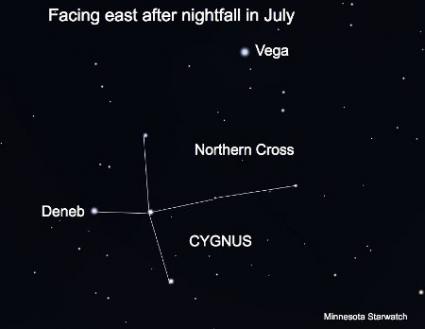Northern Sky: July 20 - Aug 2
NORTHERN SKY - Deane Morrison
July 20 - August 2, 2019
Today, in honor of the 50th anniversary of the moon landing on July 20, I’d like to talk about how it happened and why it was scientifically important.
On July 20, 1969 the moon was a waxing crescent in the evening sky. The Apollo 11 astronauts had a landing site all picked out near the border with Earth’s shadow, where it was just past sunrise. As the computer aboard the lunar module, the Eagle, guided them down, Neil Armstrong and Buzz Aldrin watched the moonscape go by below them. At about 33,000 feet, an alarm suddenly went off. Nothing in their training had prepared them to figure out what it was. They spent several minutes trying to identify it before Mission Control finally told them not to worry; it was just the Eagle’s computer reacting to being overloaded.
While the astronauts were chasing this wild goose, the lunar module used a lot of propellant fuel, and when the fuel tank dipped to half full, the propellant started sloshing around and knocking the module every which way. The sloshing also set off a “low fuel” alarm prematurely, and so the crew thought they had less time to land than they actually did.
These issues also kept Armstrong from checking out the landing site visually. At about 2,000 feet, he finally did, and he saw that the site was a boulder field—not smooth ground at all. At about 540 feet, Armstrong took manual control of the spacecraft. Despite the disruptions, he was able to guide the lunar module past the boulder field and set it down with just 20 seconds left before they would have been forced to land wherever they were or abort the landing.
Apollo 11 brought back 46 pounds of moon rocks. In all, 842 pounds of moon rocks came back on Apollo spacecraft. The oldest are 4.5 billion years old, same age as Earth. They indicated that the moon, like Earth, was also once covered by an ocean of magma. But unlike Earth, which has an iron core, the moon has very little iron and came from the same stuff as Earth’s mantle. These findings support what was once a radical idea: that the moon didn’t condense out of the same cloud of solar system material as Earth, nor was it captured later by Earth, but it formed when another planetary body collided with an infant Earth that was still molten. The collision knocked out material from Earth’s mantle, and perhaps from the other body, and this material coalesced to become the moon.
Also, moon rocks record impacts from collisions, and the number of impacts apparently spiked around 700 million years after Earth and the moon formed. An explanation for why so many more objects should have been flying around the solar system and hitting the moon—and Earth, of course—at that time is part of a leading theory of how the solar system formed. Simply put, it says that early on, gravitational interactions between Jupiter and Saturn destabilized the entire solar system and pushed the orbits of Saturn, Uranus and Neptune farther out. This changing gravitational landscape disrupted the orbits of numerous small bodies far from the sun, collectively called protoplanetary debris, and scattered them throughout the solar system. The result was an outbreak of collisions that lasted until most of the debris was cleared. And this outbreak, called the late heavy bombardment, left its signature in the spike of impacts imprinted in the moon rocks.
Scientists are still debating exactly how the moon formed and what the moon rocks tell us. But by any measure, these rocks are among the most valuable items of all time.
Deane Morrison writes the Minnesota Starwatch column for the University of Minnesota’s Minnesota Institute for Astrophysics.
Tweet




